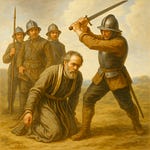For More Events on This Day in Irish History - https://thisdayirishhistory.com/may-15/
Welcome back to This Day in Irish History. I'm your host, Raymond Welsh. Before we dive into today’s story, if you’d like to explore other significant events that happened on this day in Irish history, visit thisdayirishhistory.com—the link is in the episode description. Now, let’s journey back to May 15, 2003, when a startling discovery in County Offaly pulled back the curtain on life and death in Iron Age Ireland. This was the day the remains of Old Croghan Man were unearthed—one of the most extraordinary bog bodies ever found on the island.
It was a damp, unassuming day near Croghan Hill, a site steeped in myth and local lore, when workers cutting peat in a bog stumbled upon what appeared to be human remains. But these were no ordinary remains. What emerged from the rich, dark peat was the upper torso and arms of a man, so well preserved that the pores of his skin were still visible, and the manicured fingernails on his powerful hands looked as if they’d been trimmed just days before. He would soon be named Old Croghan Man, after the nearby hill—once believed to be the inauguration site of ancient kings.
Radiocarbon dating placed his death between 362 and 175 BCE, placing him firmly in the Irish Iron Age. At over 2,000 years old, he was astonishingly well-preserved thanks to the unique anaerobic and acidic conditions of the bog, which prevent the typical processes of decay. But what was truly remarkable about Old Croghan Man wasn’t just his state of preservation—it was what his body told us about his life, and even more chillingly, his death.
Standing an estimated six foot six in life, Old Croghan Man was unusually tall for his time, suggesting that he was well-nourished and likely of high status. Forensic analysis revealed that he had not done manual labor, and isotope studies of his hair and nails indicated a rich, meat-heavy diet. In a society where most people struggled for sustenance, this man had access to privilege. But this privilege did not spare him from a brutal end.
The forensic evidence paints a harrowing picture. He was subjected to a ritual killing—a so-called “triple death.” His nipples were deliberately cut, a significant act in Iron Age Irish ritual, symbolically stripping him of kingship or power. He was stabbed in the chest, had his arms pierced with wooden stakes, and was finally dismembered. His body was then deposited in the bog, a liminal space that Iron Age people often associated with the supernatural or divine.
What makes this even more compelling is that Old Croghan Man is not an isolated case. Just months earlier, another bog body—Clonycavan Man—was discovered in County Meath. Like Old Croghan Man, Clonycavan bore evidence of high status and a ritual death. The two are often considered together by archaeologists and historians, providing a rare glimpse into a society where kingship was not only political but profoundly spiritual. These men may have been kings or sacrificial offerings intended to restore fertility to the land or appease the gods.
Croghan Hill itself adds to the story’s mystique. This was not a random patch of bog. The hill was likely a focal point of ritual activity, with its imposing presence and deep mythological connections. Some scholars suggest that human sacrifice, particularly of high-status individuals, may have been part of a larger ritual calendar—an offering for a failing harvest, a response to social unrest, or a renewal of a sacred kingship.
The discovery of Old Croghan Man also served as a turning point in how we understand Ireland’s prehistoric past. No longer reliant solely on mythology or fragmentary archaeological records, we now had the physical remains of a man who lived, ate, ruled, and died in a world long lost to history. His body is both a relic and a narrative—telling us about diet, power structures, belief systems, and the brutal undercurrents of Iron Age spirituality.
Today, Old Croghan Man rests in the National Museum of Ireland in Dublin, where he continues to fascinate scholars and visitors alike. His story is a haunting reminder of Ireland’s ancient rituals and the often-violent symbiosis between kingship and the divine. In death, he has become a symbol not of decay, but of enduring historical resonance.
Thank you for joining me on this journey through Ireland’s rich past. Please like and subscribe, and until next time, I’m Raymond Welsh—Slán go fóill!











Share this post